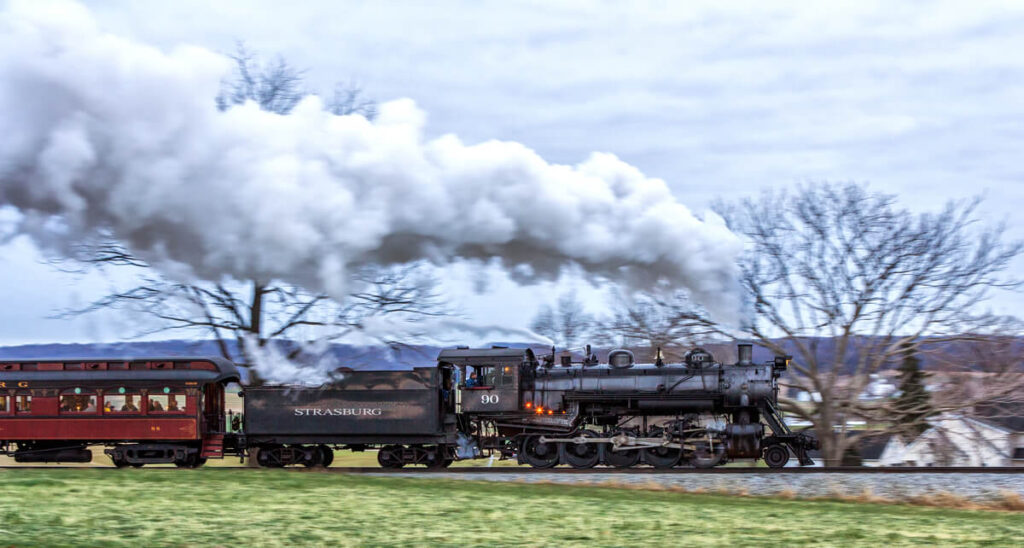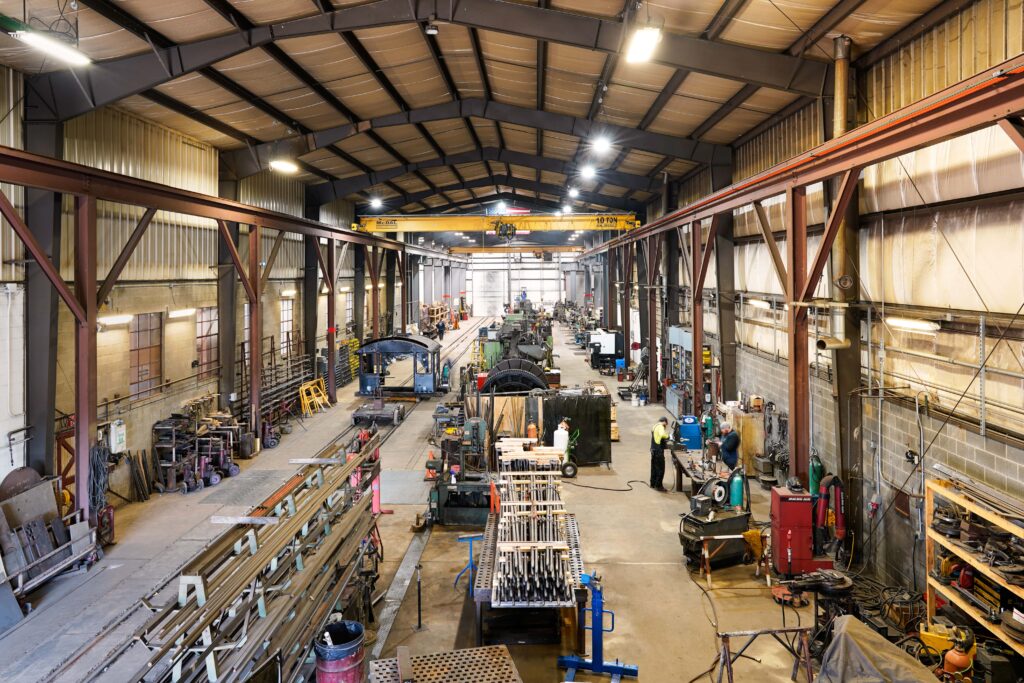The Evolution & History of Steam Locomotives
One of the most important inventions of the modern age is the steam locomotive. It helped the United States become an industrialized, global force by allowing for the country’s expansion both geographically and economically.
After briefly discussing the history of steam locomotives, we’ll discuss how the steam locomotive changed society’s thoughts on travel, and how the steam engine is still used today.

What is a Steam Locomotive?
The steam locomotive is a self-propelled vehicle, primarily used to pull unpowered cars hauling passengers or goods along tracks made of iron or steel rails. It consists of a boiler to produce steam at high pressures, usually two steam engines that convert the steam into mechanical work, and a running gear.
The running gear consists of a frame, wheels, axles, bearings, spring rigging (suspension system), and driving rods that convert the work of the engines into a rolling motion to move along the tracks. A steam locomotive carries its water supply for generating steam and coal, oil, or wood for heating the boiler.
A Brief History of Steam Locomotives
The evolution of steam locomotives can’t be talked about without mentioning the history of the steam engine, which is older than most people realize.
The steam engine originated from the aeolipile, designed by Heron of Alexandria in the Second Century B.C. An aeolipile was an apparatus that consisted essentially of a closed vessel (such as a globe or cylinder) with one or more protruding bent tubes out of it, where steam is made to pass from the vessel. The action of the steam jets causes it to revolve.
In the 1690s, Thomas Savery patented a pump with hand-operated valves to raise water from mines by suction produced by condensing steam.
Thomas Newcomen invented an effective and practical steam engine in the early 1710s. The steam engine he designed was similar to Savery’s design and consisted of a piston and cylinder arrangement coupled to a pump through a rocking beam.; used coal
James Watt improved the Newcomen engine in 1765 by adding a separate condenser to avoid heating and cooling the cylinder with each stroke. Then Watt developed a new engine that rotated a shaft.
An early steam carriage, which was ultimately cumbersome, was designed for roads in France by Nicholas-Joseph Cugnot as early as 1769. The first practical steam railway locomotive that pulled carriages was introduced by Richard Trevithick in 1804.
The adaptation of the steam engine to railways became a commercial success with English engineer George Stephenson’s The Rocket in 1829. In America, the first successful steam locomotive was the Tom Thumb, which was built in 1827. It was used by the Baltimore & Ohio Railroad and weighed five tons.
Steam locomotives were mainly used for railroad motive power until WWII. Then the focus shifted to electricity and diesel engines to power locomotives.
Steam locomotives increased rapidly in size and power, but the essential principles remained the same throughout their evolution. Early locomotives were developed through trial and error.
By the time steam locomotives were replaced by newer technologies, they had developed into highly refined machines, designed through scientific research and complex engineering.
What Were the Effects of Steam Locomotives?
Before the steam locomotive, most people didn’t travel past the borders of the state they were born in, much less move across the country. With the invention and adoption of the steam locomotive, society became mobile and pursued opportunities that had been out of reach.
How Did the Steam Locomotive Change Trade?
Steam locomotives made travel and transportation easier and faster. Steam locomotives could be operated year-round in nearly every climate. They allowed the country to expand into distant and remote territories.
It allowed for the development of suburban areas, where people could commute to urban centers for work from more rural areas.
Railroads provided jobs for:
- Workers building tracks.
- Conductors and brakemen to direct and assist with making up and moving trains.
- Engineers and firemen drive the trains and fuel the fires that gave them power.
- Manufacturing jobs building the locomotives and the cars they pulled, rails and other parts of the track structure, production of the raw materials, and the machines that made these things possible.
- Train station workers including ticket takers, schedulers, and porters.
Steam locomotives helped businesses move goods across the country quicker, resulting in higher profits and markets expanded. Farmers could move their goods to different locations before the products would spoil.
How Did The Steam Locomotive Change Transportation In America?
Steam locomotives changed not only how people were transported but how people thought about transportation.
Having an easier mode of transportation changed how people thought about vacations, which had been initially something only the wealthy could afford. With the adoption of the steam locomotive, trains could allow for weekend vacations or day trips to places like beach-side resorts or cities like Atlantic City.
Railroad operation created the need for standardized time and time zones. Every city or town had train stations and clocks but all had different time standards. Trains needed to be on the same time and schedule so there weren’t any collisions.
People needed to know what time trains were coming through so they could board the trains.
What Changes Have Been Made?
Though the basic design of the steam locomotive remained mostly unchanged for over a century, many technological improvements were made to their design and construction that improved reliability, efficiency, and performance
Manufacturing
Improvements in manufacturing technology allowed for steam locomotives and parts to grow in size as larger machines, cranes, and factory buildings were built. By the end of the steam era, the most powerful locomotives in operation had more pulling power than over 200 of the earliest steam locomotives combined.
Stronger, lighter-weight materials were used to ensure parts did not grow in weight as they grew in size, allowing larger, more powerful locomotives to operate on existing track structures.
Efficiency & Performance
Efficiency and performance were increased by improving key components and by adding accessories. The principles of thermal and fluid dynamics became better understood and applied.
Boilers were improved to burn less fuel relative to the amount of steam produced while increasing in size to generate more power overall. Cylinders and steam passages were designed to allow steam to flow into and out of the engines freely. Freer breathing engines could use less steam to produce a greater power output.
Accessories like superheaters and feedwater heaters recycled heat energy that would typically be wasted to capture more energy from the fuel being burned.
Mechanical stokers replaced manual shoveling of coal and could feed much more fuel than a human could without breaks. Incorporating oil as a fuel also improved efficiency, providing the opportunity to turn on and turn off the fire as needed.
Stronger Materials
Reliability was improved by the incorporation of new, stronger materials and by using new technologies.
Steel began to replace wrought and cast iron parts due to its increased strength-to-weight ratio. Steel parts were less prone to breakage and reduced the need for some repairs. Roller bearings replaced older, plain-style bearings, and could run for longer periods without servicing. Plus they were less prone to damage.
Automatic lubrication systems allowed locomotives to run for longer distances at higher speeds without stopping.
Is the Steam Engine Used Today?
Steam locomotives ultimately fell out of favor due to diesel and electrical engines. Steam locomotives are 5-7% thermally efficient while diesel locomotives are 30-40% efficient, meaning the steam locomotive needs to burn 6 to 8 times more fuel to do the same amount of work.
Steam locomotives are primarily operated as novelties at this time and are unlikely to make a comeback. You can visit them and learn about the history of steam locomotives at heritage centers, like Strasburg Rail Road. Strasburg Rail Road also offers many rides and experiences on an authentic steam locomotive.
Over the 100-plus years of their evolution, the steam locomotive began as an individual, small prototype with completely open cabs, tiny boilers, and lesser pulling power, and evolved into a refined machine with tremendous power, having standard design features and built in large numbers.
At Strasburg Rail Road Mechanical Services, we are dedicated to preserving these pieces of history for future generations. With over 250 years of combined experience, our experts are equipped with the tools to save these locomotives and restore them to their former glory. They can also fabricate parts that aren’t made anymore.

Strasburg Rail Road Mechanical Services is dedicated to the maintenance and restoration of steam locomotives. Our workshop and highly-trained experts provide the utmost care and professionalism to all projects. Contact us to see how Strasburg Mechanical Services can assist with your project.
